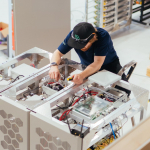5 ways engineers are helping to reduce climate change
Greenhouse gas emissions are around 50% higher than they should be. We are living in a world tarnished by global warming. End of the world films no longer seem like far-off, natty escapism but instead are a very real concern.
In the 1970s meteorologist, Jonathan Shanklin, suspected that the planet’s Ozone layer was deteriorating. By the mid-1980s, that suspicion was confirmed after it was recorded that the Ozone layer over Antarctica’s Halley Bay has lost one third of its thickness when compared to previous decades.
Shanklin and his team realised there was a connection between the depleting Ozone layer and the man-made compound chlorofluorocarbons (CFCs), which is used in things such as aerosols and cooling devices.
The discovery put the world on alert, and combative actions began to take place to set the planet on a new path.
Now, according to a UN report, the Ozone layer is recovering and on track to help avoid global warming by 0.5oC. This recovery is expected to happen over the next four decades, which is a happy boon for positive climate change.
However, Dr David Whitehouse, Science Editor at Net Zero Watch is somewhat less optimistic, citing that the ozone naturally gets thinner and thicker at certain times of the year. He comments that data from the past three years shows that the Ozone, which usually starts opening in late September and ends in November is instead closing at the end of December.
This behavioural difference isn’t suggestive that the planet isn’t recovering, but it invites debate about the timeframe, and, suggests Whitehouse, that “no one is quite sure what is happening” when it comes to understanding why the behaviour is changing.
One thing that can be agreed on, however, is that engineers are continually striving to make the planet a greener place to be.
And, to celebrate engineers making a positive change everywhere, Electronic Specifier takes a look back over 5 of the top innovations aiding in the reduction of greenhouse gas emissions and putting the planet back on track.
From wind power to sugar rush – recycling comes full circle

What do wind turbine blades, gummy bears, plexiglass, and nappies all have in common?
They all share carbon, and they have all derived from the same wind turbine blade – putting a whole new spin on the circular economy.
Dr John Dorgan, Professor of Chemical Engineering and Materials Science at Michigan State University, led a research team who began their journey of looking at the recyclability of wind turbines, by starting with the end of their life in mind. (read more.)
Plastic carbon reduction for new vehicles by digitising sustainable compounds
 Thumbnail.jpeg)
Hexagon’s Manufacturing Intelligence division and Sumika Polymer Compounds Europe (SPC Europe), a manufacturer of thermoplastic compounds, have partnered to digitise the performance of new sustainable automotive-grade polypropylene (PP) compounds, enabling engineers to design components that are more recyclable and offer a lower carbon footprint for future vehicles.
Sumika Polymer Compounds’ short glass-fibre polypropylene (GF-PP) THERMOFIL HP and recycled polypropylene (GF-rPP) THERMOFIL CIRCLE materials benefit from sustainable manufacturing and recycling processes and offer carmakers performance equivalent to incumbent engineering plastics, but with an up to 60% lower carbon footprint. (read more.)
National rail tickets go green

Paragon ID has revolutionised the rail ticket production process to reduce the environmental impact by 87%.
The familiar orange rail ticket was previously manufactured using a solvent-based system to produce the magnetic strip on the reverse of the ticket, which holds passenger journey data and is read by entry and exit barriers. In partnership with the Rail Delivery Group (RDG), a two-year-long project involved a £230k investment to change the solvent-based production system to a water-based one.
During the project, a total of 11,000 tickets were tested for durability and compatibility with the rail network. This was carried out using the testing facilities at RDG and in conjunction with various ticket machine manufacturers and operators such as Fast Rail Tickets, Flowbird, LNER and Hull Trains. (read more.)
Turning abandoned mines into batteries

A novel technique called Underground Gravity Energy Storage turns decommissioned mines into long-term energy storage solutions, thereby supporting the sustainable energy transition.
Renewable energy sources are central to the energy transition toward a more sustainable future. However, as sources like sunshine and wind are inherently variable and inconsistent, finding ways to store energy in an accessible and efficient way is crucial. While there are many effective solutions for daily energy storage, the most common being batteries, a cost-effective long-term solution is still lacking. (read more.)
Finnish startup to answer the energy crisis with second-life Tesla batteries

Cactos turns second-life EV batteries into smart energy storage units that are connected to its proprietary cloud-based control software.
The units can optimise energy consumption, provide uninterrupted power, hedge against market volatility, and provide demand response to the grid.
Cactos has raised a total of €2.5M in equity and debt led by Superhero Capital, with participation from Cactos’s founders. The funding will fund the company's growth, including increased energy storage unit production, production facility expansion, and international projects, as Cactos answers unprecedented demand for its products with Europe facing its biggest energy crisis in decades. (read more.)







